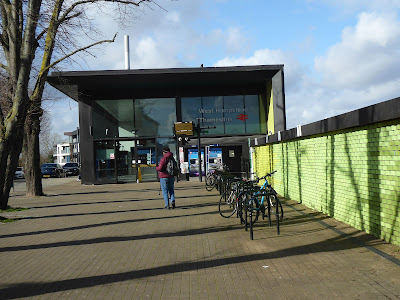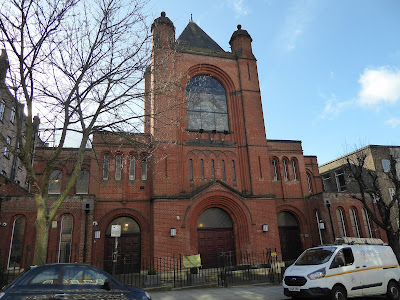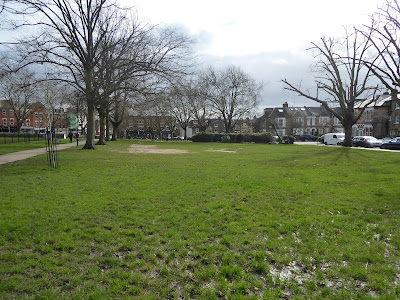The station has an island platform between the two Jubilee rail lines. Metropolitan line services run past the station on their own tracks either side of the Jubilee Line. The platform has a 1930s art deco style waiting room.
The platform is a different height to the tube train doors. You need to step up to it. There are announcements warning you of this but who pays attention to announcements when alighting a train? I wonder how many people trip over as they exit the train.
The Thameslink station takes you to St Albans and Luton or the other direction takes you into Central London.
The new Thameslink station was opened in 2011. It is set back from West End Lane to ease congestion on the narrow pavements. There have been proposals since before 1990 to link the three stations possibly via an underground tunnel but although many suggestions have been made no plans have yet been submitted.
It is still a church and holds regular services on Sundays and holy days.
The main entrance to the church is from the front and the Sheriffe centre has its own entrance at the side. As far as I am aware this is the first time a joint venture of this kind has taken place in the UK. Many deconsecrated churches have been converted for a variety of uses but the difference here is that this is still a church.
Also on Sheriffe Road is this building with inscription West Hampstead Studio. The only information I could find on these studios was that this was where the Beatles came for their second photographic session with photographer Robert Whitaker in 1965. An elaborate set was used made up of mirrors, silver foil, polystyrene for the shoot. One photo from this session was used on the cover of the EP 'Yesterday'. The building now seems to be divided into residential apartments.
The West Hampstead Studios is not the only connection this area has to the Beatles. This building on Broadhurst Gardens, a few minutes walk from Sheriffe road was the Decca recording studios from 1937 to 1981. It was here that the Beatles auditioned on New Year's day 1962 which resulted in the famous quote: 'The Beatles have no future in show business'.
The building was built in 1884 as a workshop and then converted into West Hampstead Town Hall. Despite the name this was not a public building but a private venue one that could be hired for weddings or other events. In 1928 it became the recording studio of the Crystalate Record company, a small independent record company. When Decca took over it moved all its recording to Broadhurst Garden. Artists such as David Bowie, Marc Bolan, Tom Jones, The Moody Blues, Eric Clapton and many more all recorded albums here. Bing Crosby made one of his last albums, Feels Good, Feels Right here in August 1976. When Decca left in 1981 the building was renamed Lilian Baylis House and is used by the English National Opera. In 1921 the building was given a Grade II listing.
 At the corner of Broadhurst Gardens and West End lane is The Railway pub. It used to have an upstairs function room known as the Klooks Kleek which hosted acts like the Rolling Stones, and Jimi Hendrix and Cream.
At the corner of Broadhurst Gardens and West End lane is The Railway pub. It used to have an upstairs function room known as the Klooks Kleek which hosted acts like the Rolling Stones, and Jimi Hendrix and Cream. Some different types of shops from the usual high street mixture. For instance this stringed instrument shop which sells and rents handmade stringed instruments. It also has a workshop here that maintains and restores instruments.
I couldn't resist going in this bookshop to have a look round. The staff were so knowledgeable and helpful and I left with a couple of excellent books.
There were a number of food shops and cafes that were very inviting.
Typical of this area are the mansion blocks of flats with shops below.
On the other corner of Dennington Park Road and West End lane is a pizzeria. Above the shop is this unusual stone plaque dated 1892. At first I thought it was a bas relief of a queen but on closer inspection it was much stranger. I could find no information at all about it on the internet.

Next to the pizzeria on Dennington Park Road is the Hampstead synagogue. It was built in 1891 and is a Grade II listed building.
Hampstead's first public library opened close by in 1901 but was destroyed by a fire bomb in 1940. A temporary library was used for the next 14 years. The present library and block of flats was built in the early 50s on another bomb site on the corner of Dennington Park Road and West End Lane. The bomb in 1944 killed all but one member of a wedding party which was being held in the building.
This tree was planted in 1902 to commemorate the coronation of Edward VII. Another tree was planted in 2012 to commemorate Queen Elizabeth's Diamond Jubilee.
I continued uphill along Fortune Green Road . Fortune Green was first recorded in 1646. This fountain at the entrance to Fortune Green was erected by the Cattle Trough and Drinking Fountain Association in the 19th century..
It was a patch of waste land where local residents had the right to graze animals, dig turf and play sports. In 1820 about a third of the land was enclosed and nine cottages were built for labourers. In 1891 the Green was put up for sale for development . But local residents prevented it being sold to maintain the residents' rights of recreation. Although the residents lost the court case they manage to find enough money from a local benefactor, the local worshipful companies of Skinners and Goldsmiths. In 1896 they finally raised enough the £7000 needed to buy the land and Fortune Green was saved. In 1971 ownership of the land was transferred to the London Borough of Camden.
At the far side of Fortune Green is a pathway that leads you to Hampstead cemetery, one of the largest cemeteries in London. In the early 1870s the local authority realised that more land was needed for burials. In 1874 the Burial Board bought this plot of land which covers about 30 acres.
I left the cemetery and wandered back to the station having enjoyed my walk around West Hampstead.

































Really interesting area to visit, I like the way the church is now used for a multiple purposes now, I have seen other churches used in this way. The place has certainly given a few bands a break on their way to fame.
ReplyDeletePS Abingdon is on my doorstep but I have never really looked around it that much
Another interesting area. Good to see the church serves the community and that the green spaces have been retained.
ReplyDeleteA nice but not exceptional area, which is probably how the locals like it.
ReplyDeleteAnother amazing journey.
ReplyDeleteThat High Street is definitely an upgrade from the usual (probably I couldn't afford anything on it for that reason!)....The Church with its community partnership is a wonderful thing and an example that, in my opinion, more should follow..... Loved the green area. The station platform landing definitely gives new meaning to "mind the gap."
ReplyDeleteYou are doing well on your station visits.
ReplyDeleteI enjoyed the read and seeing your good selection of photographs.
All the best Jan
im happy you got to visit the old cemetery, those are the best places to explore. The train colours red whit eand blue to me remind me of Mondrian designs.
ReplyDeleteI stood opposite that fire station so often in past times, awaiting a bus that did not always arrive!
ReplyDeleteHow things change, some for the better.
Great pictures, one day these ought to be collected and put into the local museum or library as in another 20 or so years all will have changed again.
These are good travels, I enjoy them.
It looks a great suburb a nice place to live. Three stations to provide lots of public transport. So good that the locals kept both the greens going.
ReplyDeleteI really enjoy seeing the old architecture and the interesting things you found in the town.
ReplyDeleteFeel free to share at My Corner of the World